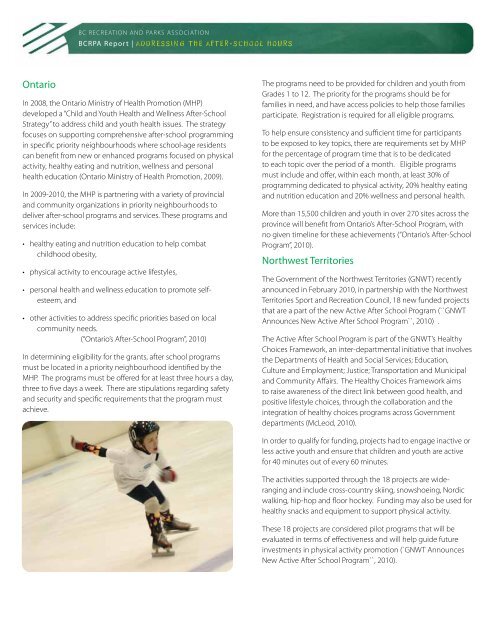BCRPA Report: Addressing the after-school hours - Middle ...
BCRPA Report: Addressing the after-school hours - Middle ...
BCRPA Report: Addressing the after-school hours - Middle ...
Create successful ePaper yourself
Turn your PDF publications into a flip-book with our unique Google optimized e-Paper software.
Ontario<br />
12 | www.bcrpa.bc.ca<br />
BC RECREATION AND PARKS ASSOCIATION<br />
<strong>BCRPA</strong> <strong>Report</strong> |<br />
In 2008, <strong>the</strong> Ontario Ministry of Health Promotion (MHP)<br />
developed a “Child and Youth Health and Wellness After-School<br />
Strategy” to address child and youth health issues. The strategy<br />
focuses on supporting comprehensive <strong>after</strong>-<strong>school</strong> programming<br />
in specific priority neighbourhoods where <strong>school</strong>-age residents<br />
can benefit from new or enhanced programs focused on physical<br />
activity, healthy eating and nutrition, wellness and personal<br />
health education (Ontario Ministry of Health Promotion, 2009).<br />
In 2009-2010, <strong>the</strong> MHP is partnering with a variety of provincial<br />
and community organizations in priority neighbourhoods to<br />
deliver <strong>after</strong>-<strong>school</strong> programs and services. These programs and<br />
services include:<br />
• healthy eating and nutrition education to help combat<br />
childhood obesity,<br />
• physical activity to encourage active lifestyles,<br />
• personal health and wellness education to promote selfesteem,<br />
and<br />
• o<strong>the</strong>r activities to address specific priorities based on local<br />
community needs.<br />
(“Ontario’s After-School Program”, 2010)<br />
In determining eligibility for <strong>the</strong> grants, <strong>after</strong> <strong>school</strong> programs<br />
must be located in a priority neighbourhood identified by <strong>the</strong><br />
MHP. The programs must be offered for at least three <strong>hours</strong> a day,<br />
three to five days a week. There are stipulations regarding safety<br />
and security and specific requirements that <strong>the</strong> program must<br />
achieve.<br />
The programs need to be provided for children and youth from<br />
Grades 1 to 12. The priority for <strong>the</strong> programs should be for<br />
families in need, and have access policies to help those families<br />
participate. Registration is required for all eligible programs.<br />
To help ensure consistency and sufficient time for participants<br />
to be exposed to key topics, <strong>the</strong>re are requirements set by MHP<br />
for <strong>the</strong> percentage of program time that is to be dedicated<br />
to each topic over <strong>the</strong> period of a month. Eligible programs<br />
must include and offer, within each month, at least 30% of<br />
programming dedicated to physical activity, 20% healthy eating<br />
and nutrition education and 20% wellness and personal health.<br />
More than 15,500 children and youth in over 270 sites across <strong>the</strong><br />
province will benefit from Ontario’s After-School Program, with<br />
no given timeline for <strong>the</strong>se achievements (“Ontario’s After-School<br />
Program”, 2010).<br />
Northwest Territories<br />
The Government of <strong>the</strong> Northwest Territories (GNWT) recently<br />
announced in February 2010, in partnership with <strong>the</strong> Northwest<br />
Territories Sport and Recreation Council, 18 new funded projects<br />
that are a part of <strong>the</strong> new Active After School Program (``GNWT<br />
Announces New Active After School Program``, 2010) .<br />
The Active After School Program is part of <strong>the</strong> GNWT’s Healthy<br />
Choices Framework, an inter-departmental initiative that involves<br />
<strong>the</strong> Departments of Health and Social Services; Education,<br />
Culture and Employment; Justice; Transportation and Municipal<br />
and Community Affairs. The Healthy Choices Framework aims<br />
to raise awareness of <strong>the</strong> direct link between good health, and<br />
positive lifestyle choices, through <strong>the</strong> collaboration and <strong>the</strong><br />
integration of healthy choices programs across Government<br />
departments (McLeod, 2010).<br />
In order to qualify for funding, projects had to engage inactive or<br />
less active youth and ensure that children and youth are active<br />
for 40 minutes out of every 60 minutes.<br />
The activities supported through <strong>the</strong> 18 projects are wideranging<br />
and include cross-country skiing, snowshoeing, Nordic<br />
walking, hip-hop and floor hockey. Funding may also be used for<br />
healthy snacks and equipment to support physical activity.<br />
These 18 projects are considered pilot programs that will be<br />
evaluated in terms of effectiveness and will help guide future<br />
investments in physical activity promotion (`GNWT Announces<br />
New Active After School Program``, 2010).


